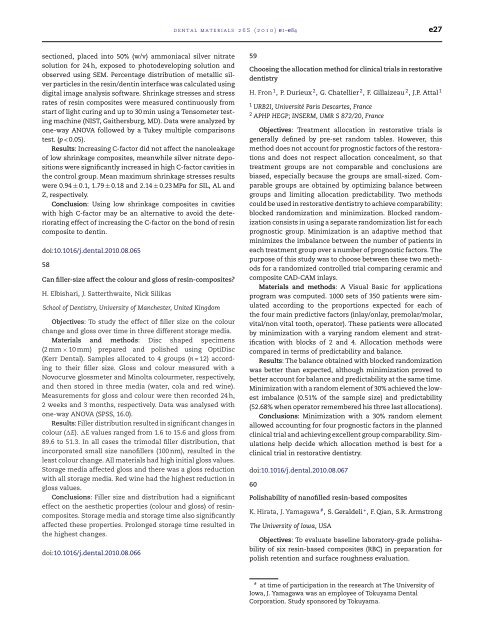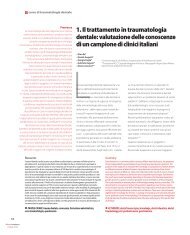Abstracts of the Academy of Dental Materials Annual ... - IsiRed
Abstracts of the Academy of Dental Materials Annual ... - IsiRed
Abstracts of the Academy of Dental Materials Annual ... - IsiRed
Create successful ePaper yourself
Turn your PDF publications into a flip-book with our unique Google optimized e-Paper software.
sectioned, placed into 50% (w/v) ammoniacal silver nitrate<br />
solution for 24 h, exposed to photodeveloping solution and<br />
observed using SEM. Percentage distribution <strong>of</strong> metallic silver<br />
particles in <strong>the</strong> resin/dentin interface was calculated using<br />
digital image analysis s<strong>of</strong>tware. Shrinkage stresses and stress<br />
rates <strong>of</strong> resin composites were measured continuously from<br />
start <strong>of</strong> light curing and up to 30 min using a Tensometer testing<br />
machine (NIST, Gai<strong>the</strong>rsburg, MD). Data were analyzed by<br />
one-way ANOVA followed by a Tukey multiple comparisons<br />
test. (p < 0.05).<br />
Results: Increasing C-factor did not affect <strong>the</strong> nanoleakage<br />
<strong>of</strong> low shrinkage composites, meanwhile silver nitrate depositions<br />
were significantly increased in high C-factor cavities in<br />
<strong>the</strong> control group. Mean maximum shrinkage stresses results<br />
were 0.94 ± 0.1, 1.79 ± 0.18 and 2.14 ± 0.23 MPa for SIL, AL and<br />
Z, respectively.<br />
Conclusion: Using low shrinkage composites in cavities<br />
with high C-factor may be an alternative to avoid <strong>the</strong> deteriorating<br />
effect <strong>of</strong> increasing <strong>the</strong> C-factor on <strong>the</strong> bond <strong>of</strong> resin<br />
composite to dentin.<br />
doi:10.1016/j.dental.2010.08.065<br />
58<br />
Can filler-size affect <strong>the</strong> colour and gloss <strong>of</strong> resin-composites?<br />
H. Elbishari, J. Satterthwaite, Nick Silikas<br />
School <strong>of</strong> Dentistry, University <strong>of</strong> Manchester, United Kingdom<br />
Objectives: To study <strong>the</strong> effect <strong>of</strong> filler size on <strong>the</strong> colour<br />
change and gloss over time in three different storage media.<br />
<strong>Materials</strong> and methods: Disc shaped specimens<br />
(2 mm × 10 mm) prepared and polished using OptiDisc<br />
(Kerr <strong>Dental</strong>). Samples allocated to 4 groups (n = 12) according<br />
to <strong>the</strong>ir filler size. Gloss and colour measured with a<br />
Novocurve glossmeter and Minolta colourmeter, respectively,<br />
and <strong>the</strong>n stored in three media (water, cola and red wine).<br />
Measurements for gloss and colour were <strong>the</strong>n recorded 24 h,<br />
2 weeks and 3 months, respectively. Data was analysed with<br />
one-way ANOVA (SPSS, 16.0).<br />
Results: Filler distribution resulted in significant changes in<br />
colour (�E). �E values ranged from 1.6 to 15.6 and gloss from<br />
89.6 to 51.3. In all cases <strong>the</strong> trimodal filler distribution, that<br />
incorporated small size nan<strong>of</strong>illers (100 nm), resulted in <strong>the</strong><br />
least colour change. All materials had high initial gloss values.<br />
Storage media affected gloss and <strong>the</strong>re was a gloss reduction<br />
with all storage media. Red wine had <strong>the</strong> highest reduction in<br />
gloss values.<br />
Conclusions: Filler size and distribution had a significant<br />
effect on <strong>the</strong> aes<strong>the</strong>tic properties (colour and gloss) <strong>of</strong> resincomposites.<br />
Storage media and storage time also significantly<br />
affected <strong>the</strong>se properties. Prolonged storage time resulted in<br />
<strong>the</strong> highest changes.<br />
doi:10.1016/j.dental.2010.08.066<br />
dental materials 26S (2010) e1–e84 e27<br />
59<br />
Choosing <strong>the</strong> allocation method for clinical trials in restorative<br />
dentistry<br />
H. Fron 1 , P. Durieux 2 , G. Chatellier 2 , F. Gillaizeau 2 , J.P. Attal 1<br />
1 URB2I, Université Paris Descartes, France<br />
2 APHP HEGP; INSERM, UMR S 872/20, France<br />
Objectives: Treatment allocation in restorative trials is<br />
generally defined by pre-set random tables. However, this<br />
method does not account for prognostic factors <strong>of</strong> <strong>the</strong> restorations<br />
and does not respect allocation concealment, so that<br />
treatment groups are not comparable and conclusions are<br />
biased, especially because <strong>the</strong> groups are small-sized. Comparable<br />
groups are obtained by optimizing balance between<br />
groups and limiting allocation predictability. Two methods<br />
could be used in restorative dentistry to achieve comparability:<br />
blocked randomization and minimization. Blocked randomization<br />
consists in using a separate randomization list for each<br />
prognostic group. Minimization is an adaptive method that<br />
minimizes <strong>the</strong> imbalance between <strong>the</strong> number <strong>of</strong> patients in<br />
each treatment group over a number <strong>of</strong> prognostic factors. The<br />
purpose <strong>of</strong> this study was to choose between <strong>the</strong>se two methods<br />
for a randomized controlled trial comparing ceramic and<br />
composite CAD-CAM inlays.<br />
<strong>Materials</strong> and methods: A Visual Basic for applications<br />
program was computed. 1000 sets <strong>of</strong> 350 patients were simulated<br />
according to <strong>the</strong> proportions expected for each <strong>of</strong><br />
<strong>the</strong> four main predictive factors (inlay/onlay, premolar/molar,<br />
vital/non vital tooth, operator). These patients were allocated<br />
by minimization with a varying random element and stratification<br />
with blocks <strong>of</strong> 2 and 4. Allocation methods were<br />
compared in terms <strong>of</strong> predictability and balance.<br />
Results: The balance obtained with blocked randomization<br />
was better than expected, although minimization proved to<br />
better account for balance and predictability at <strong>the</strong> same time.<br />
Minimization with a random element <strong>of</strong> 30% achieved <strong>the</strong> lowest<br />
imbalance (0.51% <strong>of</strong> <strong>the</strong> sample size) and predictability<br />
(52.68% when operator remembered his three last allocations).<br />
Conclusions: Minimization with a 30% random element<br />
allowed accounting for four prognostic factors in <strong>the</strong> planned<br />
clinical trial and achieving excellent group comparability. Simulations<br />
help decide which allocation method is best for a<br />
clinical trial in restorative dentistry.<br />
doi:10.1016/j.dental.2010.08.067<br />
60<br />
Polishability <strong>of</strong> nan<strong>of</strong>illed resin-based composites<br />
K. Hirata, J. Yamagawa # , S. Geraldeli ∗ , F. Qian, S.R. Armstrong<br />
The University <strong>of</strong> Iowa, USA<br />
Objectives: To evaluate baseline laboratory-grade polishability<br />
<strong>of</strong> six resin-based composites (RBC) in preparation for<br />
polish retention and surface roughness evaluation.<br />
# at time <strong>of</strong> participation in <strong>the</strong> research at The University <strong>of</strong><br />
Iowa, J. Yamagawa was an employee <strong>of</strong> Tokuyama <strong>Dental</strong><br />
Corporation. Study sponsored by Tokuyama.



